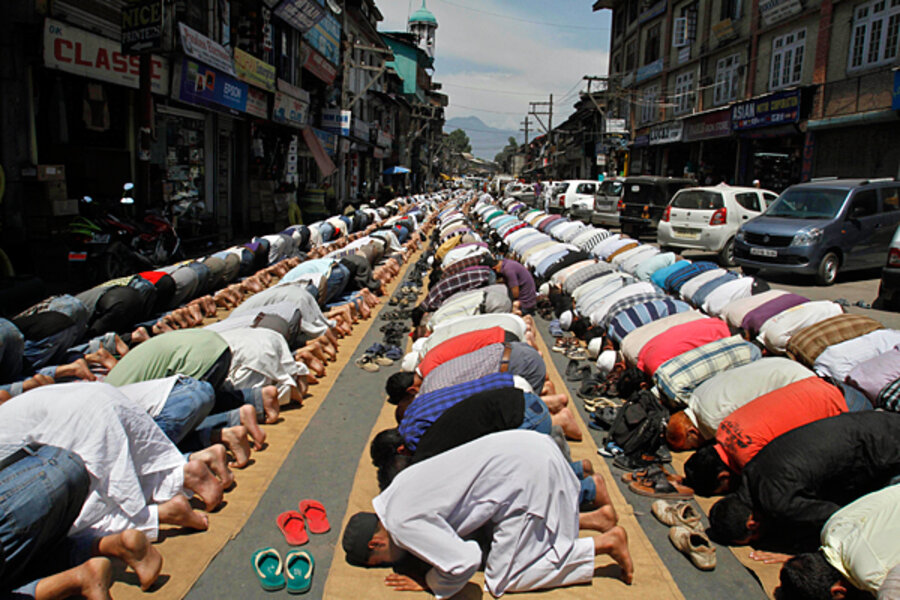Why Kashmir is so quiet - for now
Loading...
| Srinagar, Indian-controlled Kashmir
After security forces killed 117 civilians in Kashmir last summer, B.N. Ramesh took over as a top police officer here and saw a mess that his MBA degree could help him fix.
Last summer, young people led street protests against India’s presence here that prompted deadly police crackdowns, which in turn fueled more protests. This summer, in contrast, the valley has been mostly calm.
Why the calm? Young Kashmiris were not happy with the police. So Mr. Ramesh tried a new tactic: The Central Reserve Police Force in Kashmir (CRPF) began organizing sports teams for young men, hired discontented youth from 70 villages, gave away computers, and set up medical camps to offer free health care.
“People’s problems can be put into mathematical equations,” says Ramesh, who cites business management gurus like IBM’s Louis Gerstner, Jr. and Harvard University’s Michael Porter for informing his counterinsurgency theories. “The more we manage [people’s] frustration, the more … the war cries for so-called independence will calm down.”
Ramesh embodies a hope held by some Indian officials that Kashmiris can eventually be sold on Indian rule. The latest stretch of calm, the return of Indian tourists, and the wide participation in recent elections have bolstered this hope.
But nearly everyone in the Kashmir Valley is warning that underlying desires for separation from India have not changed and that unrest could return in an instant. Local business leaders in particular are urging India to take this window of opportunity to negotiate a lasting settlement of the decades-old dispute.
“This part of Kashmir has been with India for the last 63 years. You can imagine how much money they have spent here and still [separatism] has not ended,” says Siraj Ahmed, president of the Kashmir Hotel & Restaurant Association. “Ultimately, there has to be some sort of structure to address the main issue.”
Disaster for the business community
Mr. Ahmed’s group joined forces last year with the local shopkeeper’s association and a top businessman Iqbal Trumboo to form the Kashmir Economic Alliance. The group’s goal is to pressure all sides to talk and hash out a settlement – with good reason.
Last summer was a disaster for the business community. Between government curfews and separatist strikes, businesses lost 135 working days. Each day cost millions of dollars to the private sector, according to Shakeel Qalander, president of the Federation Chamber of Industries Kashmir.
After last summer, business leaders went to the separatists to explain their dire situation. “I approached them and requested them not to go for frequent strike calls because it’s self-inflicted injuries you are creating,” says Mr. Qalander.
Senior separatist leader Syed Ali Shah Geelani says the business community is supportive and “we are understanding their difficulties and we are taking that into consideration” when deciding strike calls. He warns India, however, not to misread the calm - which he calls “the lull before the storm.”
India and Pakistan
India is talking with Pakistan about Kashmir. The two countries resumed a dialogue this year that was cut after the 2008 terror attacks on Mumbai.
Before that attack, the two countries had come close to striking an agreement on Kashmir, a region they both claim but only partially control. The deal reportedly would have granted autonomy to the region and moved toward demilitarizing and softening the de facto border in Kashmir between the two countries.
Separatist leaders were reportedly consulted at various points then, but now they are making it clear that they need to be formally involved in this round of talks.
For the time being, that looks unlikely. India criticized the new Pakistani foreign minister’s call on Mr. Geelani when she visited India for talks last week. At that meeting, Geelani said areas of Kashmir under Pakistani control should also get self-determination, a departure from his previous advocacy for all of Kashmir to join Pakistan, according to The Telegraph of Calcutta.
New Delhi has dispatched fact finders to Kashmir, but months later they have still not met with the main separatists leaders of the All Parties Hurriyat Conference.
“The government of India has to realize the Hurriyat leaders need to be on board and the Pakistanis have to realize that Kashmiris have to be involved, not just the two of them,” says Mr. Trumboo.
Business leaders here cannot afford constant unrest, but without unrest New Delhi’s sense of urgency in reaching out to separatists diminishes. The Kashmir Economic Alliance is trying to deploy peaceful pressure for a lasting settlement by mustering the population behind them. The group claims to represent four million entrepreneurs and their dependents.
“It is high time. We just cannot keep hearing ‘Kashmir resolution’ and it never comes,” says Mr. Trumboo. “The pressure will be from the four million people.”
Kashmir's disgruntled youth
The youths who threw stones at police last summer, meanwhile, feel they have already achieved a crucial victory: Indian and world attention on the nearly-forgotten dispute. Conversations in recent weeks with four stone pelters revealed little concern about a loss of momentum this year.
“Maybe one year is up, one year is down, but it will continue until Kashmir gets freedom,” says Bilal. “Indians struggled for their freedom for 200 years and the pace was not continuous.”
Bilal uses a fake name for his safety. Aside from giving jobs, police have also rounded up thousands of youths and pressured their families before releasing them.
Another youth says the calm will disappear the moment security forces lose their restraint: “If any killings will happen today, things will erupt and it won’t stop,” he says.
Despite his long-term optimism, the CRPF chief Ramesh says he agrees, “Twenty years of poisoning won’t go away in a season.” He adds, “we also know one small mistake on our part will turn the thing tomorrow. It is like running a nuclear power station.”





